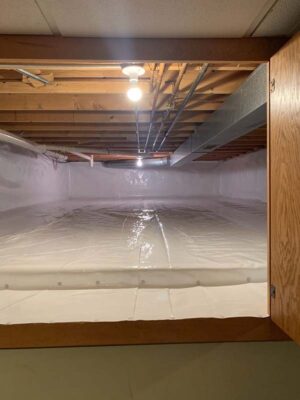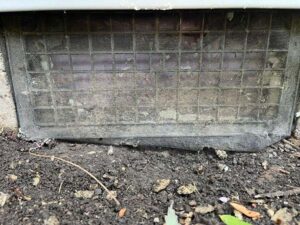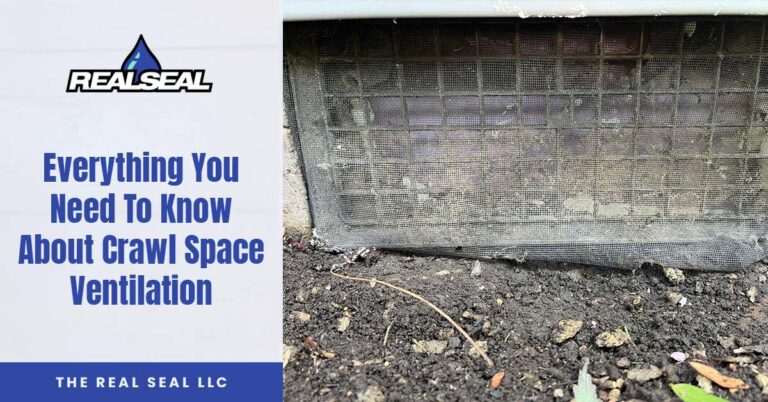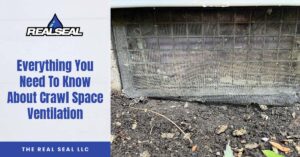What Is The Best Way To Ventilate A Crawl Space?
Ventilation is the intentional introduction of outside air into an inside space. If you allow outside air into your crawl space, you invite frost and humidity into your home. This will lead to mold, frozen pipes, warped floors, pests, increased utility bills, and more. That’s why most professionals suggest sealing and encapsulating your crawl space.
Once your crawl space is sealed and encapsulated, clean air can circulate under your home without hindrance from outside elements.

Do You Need Crawl Space Vents?
No, you do not need crawl space vents once you’ve encapsulated your foundation. Local building codes used to require vents during summer to prevent moisture buildup (this actually does the opposite) and closed during the winter to prevent frozen pipes (this does very little without encapsulation).
The International Residential Code has now changed that rule. Section 308.3, titled “Unventilated Crawl Spaces,” allows homeowners to build without vents or seal off existing openings as long as they meet certain conditions. Those conditions are,

- Mechanically circulated air should be connected between your conditioned home and crawl space – This means if you connect your HVAC system to your crawl space, you don’t need vents.
- The air-circulating device must move at least one cubic foot of air per 50 square feet of crawl space area – Your HVAC unit must handle the amount of air in your crawl space.
- The crawl space floor must be completely sealed with a vapor-retarding material – Foundation waterproofing experts should always encapsulate your crawl space walls and floors.
- The edges of the vapor retarder must be lapped up against the inner foundation walls, while overlapped separate sheets must be lapped at least 6 inches, sealing any seams – Crawl space experts should always seal the edges with seam tape.
- All crawl space walls must be insulated to appropriate R-values for the regional climate. – R-value is the amount of heat and insulation material (such as spray foam) can keep out.
What Does Crawl Space Encapsulation Not Do?
Encapsulation will catch any moisture that seeps through your crawl space walls or floors. But, without a drain tile system and sump pump to eject that water, it’s not as effective. Most experts will not encapsulate your crawl space without including a drain tile system and sump pump.
Another big misconception about encapsulation is that it will stop all water intrusion. Encapsulation is meant to prevent moisture buildup and groundwater seepage, not high water levels from floods. If you live in a flood zone or high water table, ask your foundation waterproofing expert what you should do.
What Percentage Of Air Comes From Your Crawl Space?
What Temperature Should You Keep Your Crawl Space?
What RH Level Should You Keep Your Crawl Space?
What Should Not Be Stored In A Crawl Space?
 Even if your crawl space is encapsulated, most experts advise against storing medical records, passports, birth certificates, and other important papers. Keep those items inside a safe in your home. You don’t want to search for them in the dark during an emergency, and they could get ruined if your crawl space floods. If you need to store paper items or photos in your crawl space, place them in airtight plastic containers.
Even if your crawl space is encapsulated, most experts advise against storing medical records, passports, birth certificates, and other important papers. Keep those items inside a safe in your home. You don’t want to search for them in the dark during an emergency, and they could get ruined if your crawl space floods. If you need to store paper items or photos in your crawl space, place them in airtight plastic containers.







2 Responses
Hello Mr. Werner:
I have a 1958-built brick split level house in Evanston, IL (60202).
My crawl space has 3 vents (to outdoors).
A tuckpointer recently took it upon himself to seal up two of the vents, saying that because I have a heat/AC duct in the crawlspace, I don’t need the vents.
I rec’d an unintelligible page from a building code manual from Evanston.
Can you kindly advise what kind of expert to call to inspect the crawlspace?
Thank you so much —
Jane Arao’1407 Kirk – Evanston IL 60202
tel. 847 491 1411 (voice only; doesn’t take texts)
email: [email protected]
Hi Jane!
We would be happy to help. We’ll reach out today to set up a time for us to come out and inspect the crawl space.